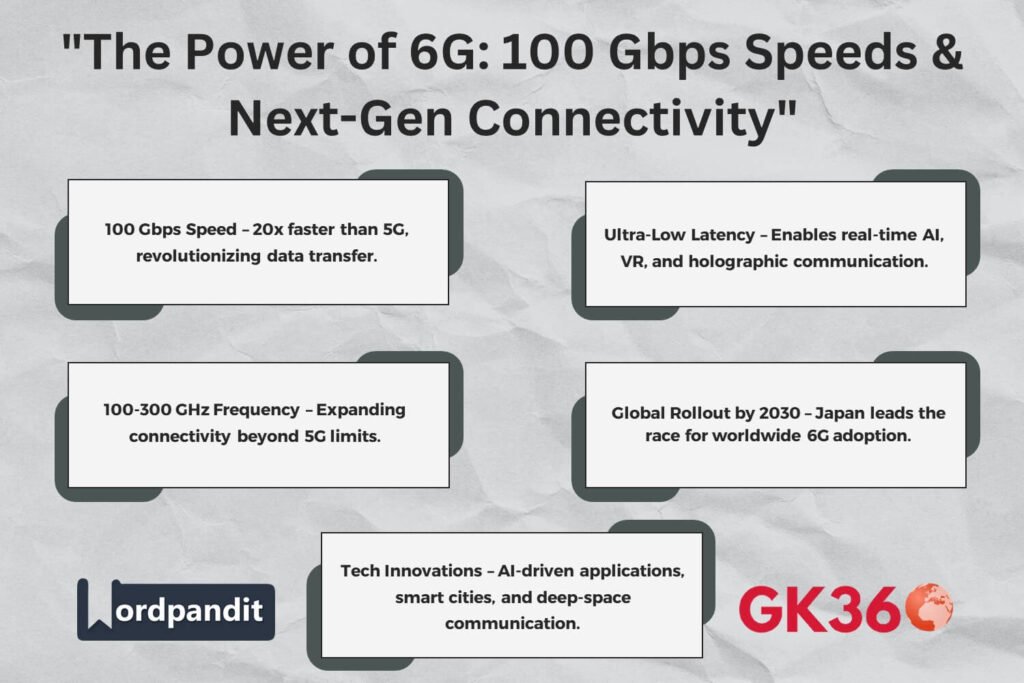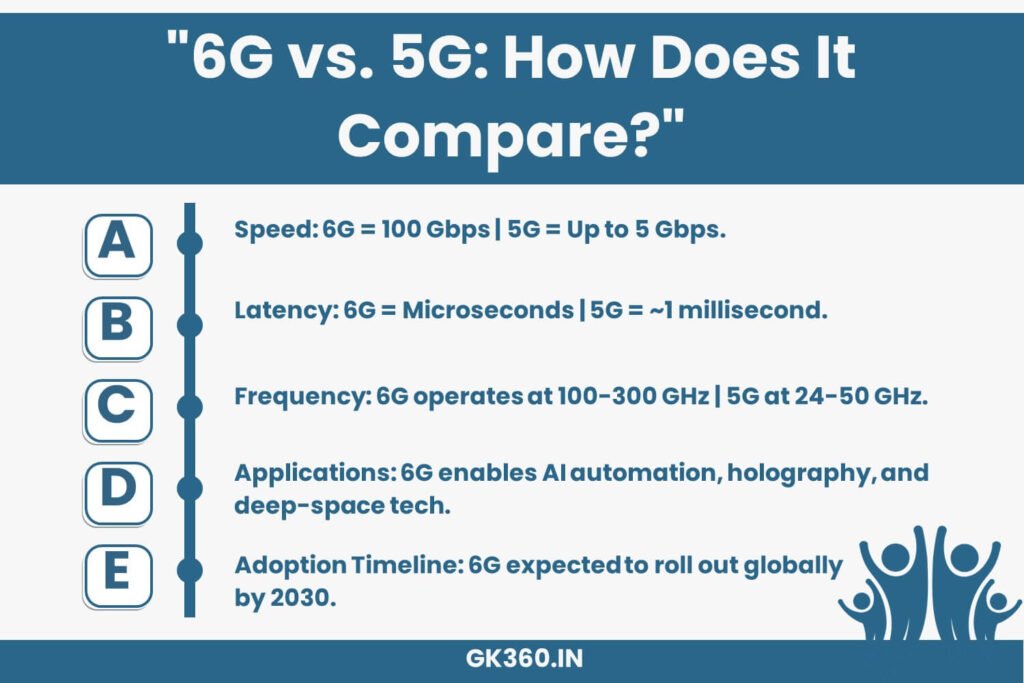Japan Unveils the World’s First 6G Device: 100 Gbps Speeds & the Future of Wireless Tech
Introduction
The race for next-generation wireless technology has taken a giant leap forward as a Japanese consortium unveils the world’s first 6G prototype device. With unprecedented data transfer speeds of 100 gigabits per second (Gbps)—20 times faster than 5G—this breakthrough redefines the future of wireless connectivity.
Operating at 100 GHz indoors and 300 GHz outdoors, the device opens new possibilities for holographic communication, immersive VR, and AI-driven applications.

Table of Contents
- Breaking Speed Barriers: The Power of 6G
- 6G vs 5G: How Does It Compare?
- Challenges of Higher Frequencies
- Real-World Applications of 6G
- How 6G Will Transform Industries
- The Road to 6G: Global Rollout & Future Prospects
- FAQs: Understanding 6G Technology
- Conclusion: The Future of Wireless Connectivity
1. Breaking Speed Barriers: The Power of 6G
Imagine downloading an ultra-high-definition movie in mere seconds. The new 6G prototype makes this a reality, offering:
- 100 Gbps data transmission – 20x faster than 5G.
- High-frequency bands – 100 GHz indoors and 300 GHz outdoors for seamless connectivity.
- Ultra-low latency – Enabling real-time AI processing, VR, and holographic communication.
💡 Key Takeaway: 6G will revolutionize communication, data sharing, and immersive experiences.
2. 6G vs 5G: How Does It Compare?
| Feature | 5G | 6G |
|---|---|---|
| Speed | Up to 5 Gbps | 100 Gbps |
| Latency | ~1 millisecond | Microseconds |
| Frequency Band | 24–50 GHz | 100–300 GHz |
| Applications | IoT, smart cities | AI-driven automation, holography, deep-space communication |
🔍 Insight: The shift from 5G to 6G represents an exponential leap, not just an incremental upgrade.
3. Challenges of Higher Frequencies
Despite its advancements, 6G faces significant hurdles:
- Shorter signal range: Higher frequencies struggle with long-distance transmission.
- Obstacle interference: Signals have difficulty penetrating walls and buildings.
- Weather sensitivity: Rain and fog can impact connectivity.
✅ Pro Tip: Researchers are exploring new materials and relay technologies to overcome these barriers.
4. Real-World Applications of 6G
Beyond faster internet speeds, 6G will reshape industries:
- AI-Powered Decision Making: Instant analysis of vast datasets.
- Immersive Virtual Reality (VR): Hyper-realistic environments for education and entertainment.
- Holographic Communication: 3D holograms replacing video calls for ultra-realistic interactions.
📌 Real-Life Example: Imagine attending a holographic classroom or a fully immersive concert from your living room!
5. How 6G Will Transform Industries
- 🚀 Healthcare: Real-time remote surgeries and AI-assisted diagnostics.
- 🚗 Transportation: Enhanced self-driving capabilities and smart traffic management.
- 🏙 Smart Cities: AI-driven urban planning and real-time resource management.
- 🤖 Artificial Intelligence: Instantaneous cloud processing for next-gen automation.
💡 Insight: The economic impact of 6G will be trillions of dollars globally.
6. The Road to 6G: Global Rollout & Future Prospects
While Japan leads in 6G innovation, a global rollout is still years away. Key milestones include:
- 2025-2027: Large-scale trials and standardization.
- 2028-2030: Commercial deployment in select regions.
- 2030+: Full-scale global adoption with widespread 6G infrastructure.
📌 Preparation Tip: Keep an eye on research from Japan, the U.S., and China as they race toward 6G dominance.

7. FAQs: Understanding 6G Technology
Q1: How fast is 6G compared to 5G?
A: 6G is 20 times faster than 5G, reaching speeds of 100 Gbps.
Q2: What frequency does 6G use?
A: 6G operates at 100 GHz indoors and 300 GHz outdoors, significantly higher than 5G’s 24–50 GHz.
Q3: What are the biggest challenges in 6G deployment?
A: Short signal range, obstacle interference, and weather sensitivity.
Q4: When will 6G be available for public use?
A: Experts predict 2030 as the target for mass adoption.
Q5: How will 6G impact daily life?
A: Expect holographic communication, real-time AI processing, and ultra-fast cloud computing.
8. Conclusion: The Future of Wireless Connectivity
Japan’s unveiling of the world’s first 6G prototype is a game-changer. With speeds of 100 Gbps, 6G will revolutionize:
- ✅ Communication: Holograms, AI chatbots, and instant global connectivity.
- ✅ Business & Industry: AI-driven automation, real-time data processing.
- ✅ Daily Life: Smart cities, immersive experiences, and seamless cloud computing.
However, challenges remain—from signal interference to infrastructure development. The next decade will be crucial in shaping how 6G becomes a reality.
💡 Want to stay updated on 6G breakthroughs? Subscribe to our newsletter for the latest insights on next-gen wireless technology!
Key Takeaways Table
| Aspect | Details |
|---|---|
| 6G Speed | 100 Gbps – 20x faster than 5G. |
| Latency | Ultra-low latency (microseconds) enables real-time AI and VR. |
| Frequency Band | 100 GHz (indoors) and 300 GHz (outdoors) for seamless connectivity. |
| Key Applications | AI automation, holography, deep-space communication, and smart cities. |
| Deployment Challenges | Shorter signal range, obstacle interference, and weather sensitivity. |
| Industry Impact | Healthcare, transportation, AI, and immersive entertainment will see major advancements. |
| Global Rollout | Expected mass adoption by 2030, with trials starting between 2025-2027. |
Related terms
- 6G Technology
- Japan 6G Prototype
- 6G vs 5G Comparison
- 100 Gbps Wireless Network
- Future of Wireless Communication
- 6G Applications in AI and VR
- Global 6G Rollout 2030
- Ultra-Fast 6G Network
- 6G Infrastructure Development





